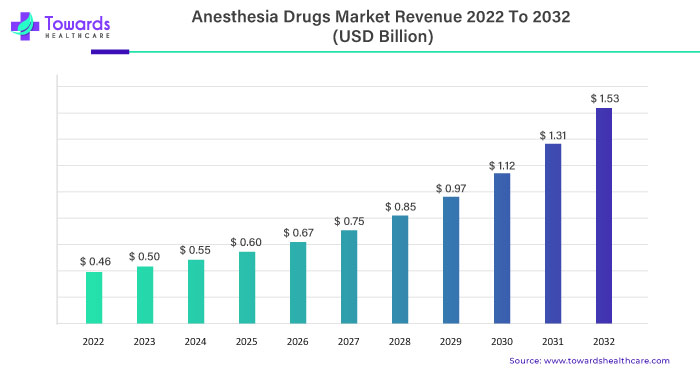Anesthesia Drugs Market Key Players, Growth Drivers and Future Trends
The global anesthesia drugs market, valued at USD 0.46 billion in 2022, is projected to grow to USD 1.53 billion by 2032, expanding at a compound annual growth rate (CAGR) of 13.3% from 2023 to 2032.

Download statistics of this report @ https://www.towardshealthcare.com/download-statistics/5019
Understanding Anesthesia Drugs
Anesthesia drugs are used to prevent pain and induce unconsciousness during surgical procedures. They help patients relax and avoid pain during surgery. There are various types of anesthesia, including general anesthesia, regional anesthesia, epidural, spinal, and nerve block anesthesia, each designed to target different types of pain.
The History of Anesthesia
The use of anesthesia began in the early 1840s when doctors started administering diethyl ether gases to make patients unconscious during surgeries. Though it caused side effects like nausea and vomiting, it was an important breakthrough. Nitrous oxide, still used today, was later introduced and has become a key agent for delivering stronger inhaled anesthetics.
The Role of Ambulatory Anesthesia
Ambulatory anesthesia has become increasingly popular, allowing patients to recover quickly and leave the hospital sooner after surgery. This approach offers significant benefits to hospitals, healthcare providers, and patients, along with lower costs for third-party payers. As anesthesia techniques and short-acting anesthetics have improved, the number of outpatient surgeries has grown significantly.
Who Administers Anesthesia?
Anesthesia procedures are typically performed by physician anesthesiologists, especially for more complex surgeries. In addition to the lead anesthesiologist, the anesthesia team may include certified registered nurse anesthetists (CRNAs), certified anesthesiologist assistants (CAAs), and fellows or residents in training.
Common Anesthesia Drugs
Propofol is one of the most commonly used general anesthetics, known for its role in surgeries and its use as a sedative in critical care units. For example, in June 2020, the FDA approved Fresenius Propoven 2% emulsion for maintaining sedation in COVID-19 patients requiring mechanical ventilation.
How Anesthesia Works
Anesthesia can be administered in several ways, depending on the type and scope of the surgery:
- Inhaled gases
- Injections, such as intravenous or shots
- Topical liquids, sprays, or patches applied to the skin or eyes
Market Growth Drivers
The growth of the anesthesia drugs market is primarily driven by the increasing number of surgeries, an aging population, and ongoing technological advancements. A rise in surgeries is linked to a higher number of traumatic injuries and accidents, with the World Health Organization reporting 1.35 million road accidents annually.
Technological innovations in drug delivery, better monitoring equipment for patients during and after anesthesia, and reduced side effects are further fueling market growth. Additionally, the global aging population, with more people suffering from chronic diseases like cardiovascular and neurological conditions, is contributing to the increased demand for anesthesia drugs. By 2050, one in four people in regions like Europe and North America will be over 65, further driving the market need for anesthesia solutions.
Our Table of Content (TOC) covers key healthcare market segments, materials, technologies and trends—helping you navigate market shifts and make informed decisions: https://www.towardshealthcare.com/table-of-content/anesthesia-drugs-a-numbing-agent-in-surgeries
Access exclusive insight now @ https://www.towardshealthcare.com/price/5019
We’ve prepared a service to support you. Please feel free to contact us at sales@towardshealthcare.com
Web: https://www.towardshealthcare.com
Visit Dental Specifics: https://www.towardsdental.com
Get the latest insights on industry segmentation with our Annual Membership: Get a Subscription
For Latest Update Follow Us: https://www.linkedin.com/company/towards-healthcare


